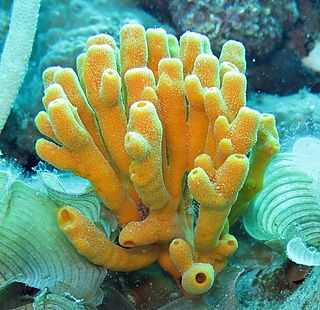
Cladorhiza is a genus of carnivorous sponges, comprising around 40 species found in oceans around the world. Cladorhiza is the type genus of the family Cladorhizidae.

Homosclerophorida is an order of marine sponges. It is the only order in the monotypic class Homoscleromorpha. The order is composed of two families: Plakinidae and Oscarellidae.

Lyssacinosida is an order of glass sponges (Hexactinellida) belonging to the subclass Hexasterophora. These sponges can be recognized by their parenchymal spicules usually being unconnected, unlike in other sponges in the subclass where the spicules form a more or less tightly connected skeleton. Lyssacine sponges have existed since the Upper Ordovician, and three families are still alive today. The Venus' flower basket is one of the most well-known and culturally significant of the glass sponges.
Clathrina multiformis is a species of calcareous sponge from Russia.
Agelas gracilis, commonly known as candy cane sponge, is a species of demosponge. It lives primarily in Australian waters. It has a symbiotic relationship with the white zoanthid making red and white polyps.

Euplectella is a genus of glass sponges which includes the well-known Venus' Flower Basket. Glass sponges have a skeleton made up of silica spicules that can form geometric patterns. These animals are most commonly found on muddy sea bottoms in the Western Pacific and Indian Oceans. They are sessile organisms and do not move once attached to a rock. They can be found at depths between 100 m and 1000 m but are most commonly found at depths greater than 500 m.
Guancha apicalis was thought to be a species of calcareous sponge in the genus Guancha from Antarctica. It actually never existed.
Cladorhiza caillieti is a carnivorous sponge of the family Cladorhizidae described in 2014 from specimens collected from the Juan de Fuca Ridge off the coast of Vancouver Island. It feeds on small crustaceans such as amphipods and copepods. C. caillieti is an elongate, bottlebrush-shaped sponge with filaments projecting from a main stem, and ranges from 7 to 9 cm in height. The specific epithet honors Dr. Gregor M. Cailliet of the Moss Landing Marine Laboratories.

Rossellidae is a family of glass sponges belonging to the order Lyssacinosa. The family has a cosmopolitan distribution and is found at a large range of depths.

Anheteromeyenia is a genus of freshwater sponge. It has been recorded in the Nearctic, the Neotropics. This taxon was initially a subgenus of Heteromeyenia when K. Schöder circumscribed it in 1927, but W. M. de Laubenfels made it a genus in its own right in 1936.

Pipestela candelabra is a species of sponge belonging to the family Axinellidae.
Michelle Kelly, also known as Michelle Kelly-Borges, is a New Zealand scientist who specialises in sponges, their chemistry, their evolution, taxonomy, systematics, and ecology.
Tethya leysae is a species of sea sponge belonging to the family Tethyidae, found in the Canadian north-west Pacific.
Euplectella cucumer is a species of glass sponge in the family Euplectellidae. It has been found around the Seychelles.
Euplectella gibbsa is a species of glass sponge in the family Euplectellidae. It has been found in the North Atlantic Ocean.
Euplectella sanctipauli is a species of glass sponge in the family Euplectellidae. It is known from type specimens found off the coast of Brazil.
Caulophacus brandti is a species of glass sponges belonging to the subfamily Lanuginellinae. It is known from type specimens found in the Weddell Sea. The specific epithet was given in honor of Angelika Brandt.
Caulophacus discohexactinus is a species of glass sponges belonging to the subfamily Lanuginellinae. It is known from a type specimen found in the Weddell Sea. The specific epithet was given to refer to the discohexactine shape of the species' microscleres.
Caulophacus weddelli is a species of glass sponges belonging to the subfamily Lanuginellinae. It is the only species in the subgenus Oxydiscus. It is known from a type specimen found in the Weddell Sea, which lends its name to the specific epithet weddelli.






